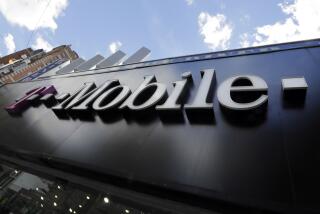Dial a Deal
- Share via
Now’s the time to take a second look at your long distance phone bill. The passage of the Telecommunications Act of 1996, the flood of companies entering the electronic bazaar and a profusion of improved calling plans translate into a callers’ market. Bargains abound. The challenge is to find the carrier that offers the lowest rates for the way you use the phone.
Though the sheer number of calling plans offered can make this money-saving process seem complex, it’s worth the effort. Since it costs Pacific Bell customers only $5.26 to change carriers--an amount that most carriers refund, or that could be recouped in one month’s savings--there’s much to be gained by looking around.
“Two-thirds of consumer households are not on a calling plan,” said telecommunication analyst Brian Adamik of the Yankee Group. “That means two-thirds of consumer households are paying the highest rates in the industry. They don’t have to. It takes no more than a phone call to their existing carrier to get a better deal.”
Right now most of the discount activity is in the long distance market, but the California Public Utilities Commission has authorized more than 70 companies to provide local phone service. This means the same price competition is coming to local service.
What to Do First
* Know thyself. Examine a couple of old phone bills and see if there’s a pattern. Do you call primarily in the daytime? At night? To the same number? Do you make a lot of international calls? Figure out what you pay per minute for each type of call.
* Shop around. Call some carriers, explain your pattern, get a price on frequently called numbers and see what’s being offered.
* When inquiring, be certain the carrier knows you’re looking only for information. Don’t let your service be switched until you’ve made a decision. “Slamming” is the word for being changed to another carrier without approval. Pacific Bell has received as many as 10,000 complaints a month about the practice.
What to Ask a Long Distance Carrier
* The per-minute rate. The holy grail is 10 or 11 cents a minute, any time day or night for out-of-state calls within the continental United States, most experts agree. It’s the price to aim for. Make sure there are no minimum requirements or billing fees.
* How is the billing timed? The consumer is better off when it’s done in six second intervals rather than rounding up to the next minute. William Hefner, editor of the Internet’s Discount Long Distance Digest (https: //www.thedigest. com) estimates that a residential customer thus saves about 5%.
* Do you get a personal 800 number? Is there a charge? A personal 800 number allows the person you give the number--perhaps a child away at school--the ability to call your home number and have the call billed to you. It’s like a collect call, but much, much cheaper. Beware of monthly service charges or minimum usage fees, which are common. Fourteen cents a minute is a good rate.
* Do do you get a calling card? Watch out for a per call surcharge. (These type of fees have the wistful, Cheech & Chong-like nickname of “bong charges” from the tone that accompanies them.) As an example, AT & T’s can be as high as 80 cents per call. A good calling card rate is less than 20 cents a minute with no monthly cost or per-use surcharge.
Tips
* You have to ask a carrier to be put on a discount plan. They don’t do it automatically. So ask. Don’t pay the basic rates. Get a plan, otherwise you’re paying full retail.
* If your primary carrier’s phone card has a surcharge or high rate, you could try American Travel Network. The company charges 17.5 cents a minute, there’s no surcharge and you’ll receive an itemized monthly bill. The network can be reached at (800) 477-9692.
* Beware of “term plans.” This is where you’re promised a rate or discount, but only if you commit to a long-term contract. With rates dropping, you could be stuck with a bad deal.
* Use collect calls only for emergencies. “The rates are almost always higher than using a standard or prepaid calling card,” said Ken McEldowney, executive director of Consumer Action.
* A rule of thumb is that the Big Three (AT & T, MCI and Sprint) offer the best deals for nights and weekends, but for daytime calls, smaller companies have the better prices.
* Get it in writing. It’s protection against being told you’ll get one rate and then receiving something else. Then be sure to check the phone bill to make sure you’re getting what you were promised.
* Look out for the fine print. As an example, some discount companies have a three minute per call minimum. Some have hidden monthly charges that offset any savings. This is especially true with international calling plans.
* Debit or prepaid cards (where you pay in advance for a prescribed amount of long distance minutes) are a simple alternative to a calling card. They can also be sent to children away at school. Since they usually have a time expiration, don’t buy them in large denominations. The rate should be less than 25 cents a minute.
* One easy way to get a comparison of long distance rates is to ask the Telecommunications Research and Action Center (TRAC) for its Tele-Tips Residential Long Distance Comparison Chart. Send a self-addressed, stamped, business-size envelope and a $5 check to TRAC, P.O. Box 27279, Washington, DC 20005.
* If you change carriers, ask if they offer any bonuses to sweeten the deal. It could be airline mileage, free calling time, cash back or the dropping of a monthly charge. The Big Three almost always offer some kind of premium.
* One technique for significant savings on international calls is to employ the “equal access” code. This is 10 followed by three digits.
It works this way: Every carrier has a 10 plus three digit code; for example, AT & T’s is 10288. If you dialed 10288 (212) 555-1212, your call to New York City Information would be carried by AT & T even if MCI is your primary carrier. AT & T’s 10288 “equal access” code allows you to bypasses MCI. AT & T’s charge would appear on your regular monthly phone bill.
By using this 10 plus 3 digit code, you can use a small company that specializes in foreign rates while using a different carrier for domestic service. Before using this “equal access” feature, call a company first and register with one of their programs to receive the best rate. Beware of minimum monthly charges.
Having Someone Else Do It for You
* You might consider going to a telecommunications broker. These companies examine consumers’ bills, then match them with a carrier that will best fit their needs. Brokers usually represent a number of long distance providers. Generally, these companies serve those who do $50 or more per month in long distance billing. Some to consider are VanTek Communications ([800] 826-8351), Online Telecommunications ([800] 364-7037) and East West Telecom ([310] 670-5288).
(BEGIN TEXT OF INFOBOX / INFOGRAPHIC)
Service by the Numbers
MAJOR CARRIERS
Following are the biggest telephone companies, in order of business volume; there are many smaller ones.
AT&T;: (800) 222-0300
MCI: (800) 444-3333
Sprint: (800) 746-3767
WorldCom: (800) 737-0773
Frontier: (800) 783-2020
Cable & Wireless: (800) 486-8686
LCI International: (800) 860-2255
Excel: (800) 875-9235
*
RESELLERS
These and other companies buy time in bulk from a carrier, then market it to consumers. Their rates can be substantially lower than those charged directly by a carrier, but they may offer less service. As an example, many don’t have 24-hour customer assistance.
USTel: (800) 544-4007
Telegroup: (800) 338-0225
Unidial: (800) 864-3405
WealthCom: (602) 641-7799
AtCall: (800) 709-4445
Phoenix Network: (800) 800-3024
NTC: (800) 569-4682
*
THE BIG THREE
Some interesting options to consider:
* AT&T;: Ask about the One Rate plan of 15 cents a minute. If you make more than 90 minutes in calls a month, there’s One Rate Plus, which is 10 cents per minute with a $4.95 monthly fee. High usage customers can sometimes haggle over this fee.
* Sprint: The Sprint Sense plan has a daytime rate of 25 cents a minute and 10 cents from 7 p.m. until 7 a.m. and all day on weekends. The Sprint Sense Day plan offers 15 cents a minute rate any time.
* MCI: If you spend more than $25 a month, the MCI One plan is 12 cents a minute any time; call less and it’s 15 cents a minute.
(BEGIN TEXT OF INFOBOX / INFOGRAPHIC)
COMPARATIVE PRICES
These figures show how by simply choosing a “plan” you can save money. Most companies offer more than one type of plan.
Average Daily Use 12 calls 106 mins.
Standard Rate Plans
AT&T; Dial-1 Standard.........$25.59
Frontier Dial-1..............$27.18
LCI Basic....................$24.87
Matrix Dial-1................$20.58
MCI Dial-1 Standard..........$25.46
Sprint Dial-1 Standard.......$25.59
WorldCom MTS.................$21.29
*
Flat Rate Plans, Calling Any Time
AT&T; One Rate................$19.70
AT&T; One Rate Plus...........$19.60
LCI Flat Rate................$17.98
Matrix Flat Rate 1...........$17.47
MCI One......................$18.93
Sprint Sense Day.............$18.85
Source: Telecommunications Research and Action Center
More to Read
Inside the business of entertainment
The Wide Shot brings you news, analysis and insights on everything from streaming wars to production — and what it all means for the future.
You may occasionally receive promotional content from the Los Angeles Times.










